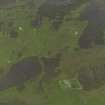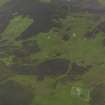Rousay, Hestivall
Farmstead (Post Medieval)
Site Name Rousay, Hestivall
Classification Farmstead (Post Medieval)
Canmore ID 182031
Site Number HY33SE 51
NGR HY 3740 3294
Datum OSGB36 - NGR
Permalink http://canmore.org.uk/site/182031
- Council Orkney Islands
- Parish Rousay And Egilsay
- Former Region Orkney Islands Area
- Former District Orkney
- Former County Orkney
HY33SE 51 3740 3294
A farmstead comprising one unroofed building, one unroofed structure, and one enclosure, and a head-dyke are depicted on the 1st edition of the OS 6-inch map (Orkney and Shetland (Orkney) 1882, sheet lxxxiv). The head-dyke is conjoined to those of the farmsteads of Lower Breck (HY33SE 52) and Breek (HY33SE 53).
One unroofed building, one enclosure and the fragmentary remains of the head-dyke are shown on the current edition of the OS 1:10000 map (1977).
Information from RCAHMS (SAH) 11 December 2000
Field Visit (12 May 2015)
The ruinous farmstead of Hestivall, which stands within its former fields – an area measuring about 4.4 acres (1.8ha) in extent, comprises a range measuring about 13m from ENE to WSW, which sits within the SSE end of a stone-walled enclosure, a second smaller building immediately to the SSE, and a third building, much robbed and presumably of an earlier date, some 10m to the SSE. All three buildings are orientated ENE and WSW, up-and-down the slope, and the two which are better preserved are rectangular and of drystone construction.
The uniform character of the SSE wall of the range suggests that it originally contained a dwelling measuring about 9.4m by 4.4m within walls up to 0.7m in thickness. A doorway at the WSW end of the SSE wall stands opposite a shelf set into the NW corner of the compartment which once housed a pair of rotary querns. A bed-neuk which projects out from the NNW wall is secondary and appears to be contemporary with the wall that divided the interior of the dwelling into two unequal spaces, the larger on the WSW. An outshot at the WSW end, which has a doorway in its SSE side, is also of secondary build, as are the remains of another outshot at the ENE end. This outshot appears to have been robbed, possibly during the construction of the enclosure (27m NNW to SSE by 17.8m) on the NNW side of the range. The ENE wall of this yard seems to overlie a low lynchet that extends to the SSE.
The second building measures about 4.3m from ENE to WSW by 3.6m transversely overall and has a doorway facing the dwelling. Its WSW end is aligned with the WSW end of the dwelling and the two are probably of similar date. The third building has been reduced to little more than a low, grass-grown mound, subrectangular on plan and measuring roughly 10.8m from ENE to WSW by up to 5.8m transversely. The few stones visible within the mound indicate that it was probably stone-built and a low scarp indicates that it contained two compartments. A shallow oval pit that encroaches upon the NW edge of the mound may be a midden contemporary with the other two buildings.
Thompson notes (1981, 46) that in 1841 the farmstead of Hestivall had two inhabitants and that in 1842 it was amalgamated with the adjacent farm of North House (HY33SE 49). Like all the other farms in the area Hestivall would have been abandoned in 1845 or very soon after. Two unroofed buildings are depicted here on the 1st edition of the OS 25-inch map (Orkney 1882, Sheet LXXXIV.2) and a contemporary reference stated that the name applied ‘to a ruin’ (Name Book 16, 11).
Visited by RCAHMS (GFG, AM) 12 May 2015.
Measured Survey (12 May 2015)
RCAHMS surveyed Hestivall farmstead with plane-table and alidade on 12 May 2015 at a scale of 1:200. The resultant plan was redrawn in vector graphics software.
Excavation (11 May 2015 - 16 July 2015)
HY 3758 3264 (Breck), HY 37384 30093 (Skaill) and HY 37289 30396 (Brough) Archaeological investigations into the Rousay clearances took place at two sites, c2.5 km apart, in the W of Rousay, 11 May – 16 July 2015. Excavation was undertaken at Breck Farmstead in Quandale in conjunction with measured and landscape survey by RCAHMS of the neighbouring farmsteads. In addition, a building recording survey was undertaken and a test pit excavated at Skaill Farm, Westness. Geophysical survey (magnetometry) was also undertaken at Skaill and nearby Brough Farm. The project was in partnership with the ongoing excavations at Swandro multi-period settlement and tombs (University of Bradford), and investigation of the multi-period landscapes of the island.
At Breck (11–22 May 2015), eight small keyhole trenches were excavated within the farm buildings and four test pits around the nearby enclosure. Breck consisted of two building ranges separated by a close (but and ben with additional room, and corn kiln, barn and byre). The earth floor in the but end had been replaced and the remains of a leather shoe was found buried in the upper floor layer. In a similar manner, the original central hearth slab in the but end had been overlain by another slab which also had a rough back wall. A ‘Z’ motif had been carved into the SW end of the lower hearth slab and may have been a good luck charm. The hearth appears to have been replaced along with the floor. Paving slabs and stone roof slabs were found in the close. The presence of window glass suggests that the stone roof had small skylights. The corn drying kiln had a flue into the barn, both had been swept clean. A dump of pottery was found in the neuk bed and byre drain. Indications are that the farm was built in the late 18th to early 19th century as an outset into the hill land beyond the hill dyke. A team from RCAHMS led by George Geddes prepared notes on 68 sites within the Quandale area, and produced measured surveys of seven farmsteads (North House HY33SE 49, Hestival HY33SE 51, Breek HY33SE 53, Cairn HY33SE 55, Knapknowes HY33SE 60).
At Skaill Farm, measured building survey was undertaken at the two ranges and corn kiln. Geophysical survey (magnetometer) was undertaken in four blocks around the farmstead and also a single block at Brough Farm. The results from Skaill indicated the presence of earlier boundaries on a different alignment to the present post-medieval boundaries, which may relate to an earlier farm.
A small test pit was excavated in the garden area adjacent to the main farmhouse to investigate potential post-medieval midden for animal bone assemblages (8–9 and 14–15 July 2015). Midden enhanced topsoil (containing pottery, animal bone, glass and a 1743 half penny) sealed a stony demolition layer (containing fish bones and a sherd of steatite) which in turn sealed a stone wall. The wall was on a slightly different alignment to the main farm building and is likely to relate to an earlier structure and the other geophysical anomalies. The steatite suggests that the earlier farm could date to the
Viking period.
Archive: Archaeology Institute, UHI
Funder: Orkney Islands Council, Orkney Archaeology Society and Archaeology Institute, UHI
Daniel Lee, Keir Strickland, Jane Downes, Ingrid Mainland and George Geddes – Archaeology Institute, UHI and HES
(Source: DES, Volume 16)




































